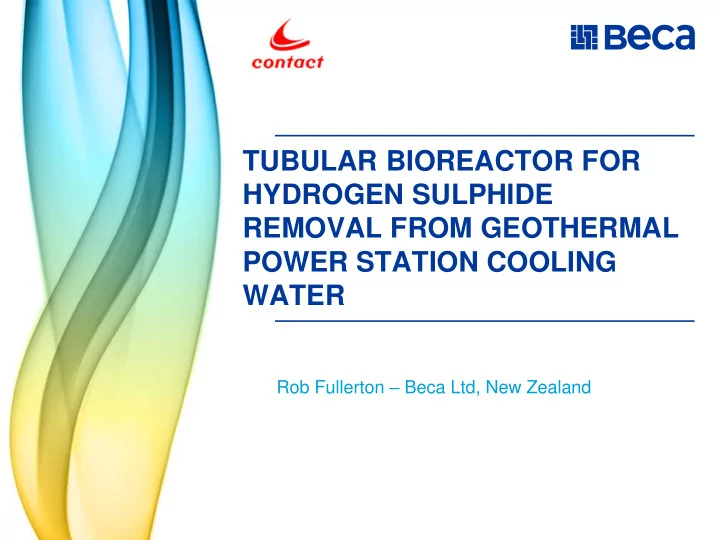

TUBULAR BIOREACTOR FOR HYDROGEN SULPHIDE REMOVAL FROM GEOTHERMAL POWER STATION COOLING WATER Rob Fullerton – Beca Ltd, New Zealand
Taupo – North Island NZ Taupo Wairakei
Wairakei Geothermal Power Station • Wairakei – one of earliest geothermal power stations in the world • commissioned 1958 – 1963, installed capacity 192MW • current capacity 157MW
Cooling Water System ~17 m 3 /s Waikato River water for direct condenser cooling A Station B Station CW in CW out CW = Cooling water
Cooling Water System Geothermal steam 0.2m 3 /s Cooling water Steam Turbines + condensate Direct contact 17m 3 /s condensers 17.2m 3 /s Water pumps 157MW power Waikato River Waikato River
The Challenge H 2 S in the geothermal steam condenses into the cooling water and is discharged back to the river – aquatic impacts H 2 S concentration in discharge about 1000mg/m 3 (~1mg/L) Discharge Permit: H 2 S discharge to river ─ Prior 2012 : No consented limit - 10,000 kg/week ─ By 20 August 2012: 2,800 kg/week (72% reduction) ─ By 20 August 2016: 630 kg/week (94% reduction) Requires sulphide reduction to ~50 mg/m 3
The Challenge Geothermal steam containing H 2 S 0.2m 3 /s Cooling water Steam Turbines + condensate 17.2m 3 /s 1000ppb H 2 S Direct contact 17m 3 /s condensers To be reduced to 50ppb by Cooling water 2012 157MW power Waikato River Waikato River
Sulphide Oxidising Bacteria - A Solution? • Need for strategy to control sulphide recognised • Thinking started in 2000 • SOB naturally occurring – esp. in geothermal areas • Biological sulphide oxidation - conversion of H 2 S to sulphate • SOB biofilm observed on existing outfall structure • Cooling water from power station 30 - 35 o C, pH ~6, dissolved CO 2 • Could SOB be used to achieve 95% sulphide removal?
Initial Pilot Trials – 2000 - 2005 Algae overgrowth
Sheets – channels - Pipes
The Eureka Moment SOBs seem to grow best in fast moving flow
Pilot Testing – Initial pipe trials Sulphide sampling • Biofilm established on inside of pipe – good H 2 S removal • High velocity prevents excessive biomass build-up • Lack of light prevents algal growth • Pipe bioreactor proved in concept
Pilot Testing 2010 100mm dia. x 200m /150mm dia. X 400m
SOB Biofilm Beginning section 100m End section 200m
100mm dia. x 200m results
150mm dia. x 400m results
Sulphide Removal Model S = substrate concentration 𝑒𝑇 𝑒𝑢 = 𝜈 𝑛 𝐶 𝑇 µ m = maximum specific growth rate 𝑍 (𝐿 𝑡 + 𝑇) K s = half-saturation constant B = biomass concentration Y = biomass yield • Sulphide concentration is low B >> S • biofilm quasi-steady state with constant thickness, viz. growth = detachment 𝑒𝑇 𝑇 dS/dt = rate of substrate change 𝑒𝑢 = −𝑤 𝑛 v m = maximum substrate utilisation rate (𝐿 𝑡 + 𝑇) k s = half saturation constant • Calculate removal rate for each pipe segment (gH 2 S/m 2 /d) • Fit to non-linear least squares Monod model
Monod curve fitting K s = 235mg/m 3 v m = 13.85 gH 2 S/m 2 /d
Design Curve Minimum pipe length ~160m +25% safety factor = 200m
Pipe bioreactor - process concept 100mm dia. x 200m Outlet Velocity 0.8m/s sulphide Flow = 6.7L/s < 50ppb 100mm Sulphide oxidising bacteria biofilm Power station cooling water forms on pipe inside surface Inlet sulphide = 1000ppb
Full scale pipe bioreactor concept plant Flow = 17m 3 /s ~2000 pipes x 200m in parallel 390km of pipe !! 200 x pipes per layer 10 layers
Proposed sulphide treatment system 2012 Geothermal steam + H 2 S Pipe bioreactor 17.2m 3 /s Steam Turbines Direct contact condensers 17m 3 /s 4.2m3/s cooling 13m 3 /s 1000ppb water 50ppb H 2 S H 2 S 157MW power 2,800kg/week 17.2m 3 /s Waikato River Waikato River
Proposed sulphide treatment system 2016 Geothermal steam + H 2 S 13.2m 3 /s 1000ppb H 2 S Pipe bioreactor Steam Turbines Direct contact condensers 13m 3 /s <80ppb H 2 S Cooling water 630kg/week 120MW power Waikato River Waikato River
Full Scale design Challenges Design began January 2011 Never been done before – collaboration between contractor and designer Physical constraints – high groundwater + hot (60 o C) Power station can’t stop – build off-line Hydraulics – available head 1.5m – require pumping Energy efficiency – design low head system How to install 380km of 100mm dia. HDPE pipe
Innovative “over – under” syphon 100m Bioreactor pipe configuration ― 1890 pipes ― 5 banks of 378 pipes ― 42 pipes x 9 layers ― Magnetic flow meter each bank
Bioreactor Layout
Site Overview December 2011
Construction of pipe field PE Pipe Design ─ Extruded on site ─ 100m lengths ─ No joints ─ 2.5mm wall ─ Embedded into weak cement matrix – “ soilcrete ” ─ 378km in 5 months
Construction of pipe field
Construction of pipe field Soilcrete embedment made from local pumice sand
Construction of pipe field
Construction of pipe field Return chamber – end pipe field
Pump inlet channel
Bioreactor outlet channel
Bypass weir
Bioreactor Performance
Permit Compliance
Full scale performance H 2 S concentration meeting target of >80% (~50mg/m 3 ) Power station meeting sulphide mass emission limit of 2,800 kg H 2 S/week Optimisation of operating conditions to minimise power consumption Current performance gives confidence to meet 2016 discharge limit of 630 kg H 2 S/week
The world’s largest tubular bioreactor
Recommend
More recommend